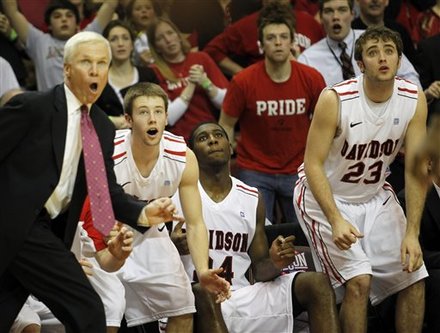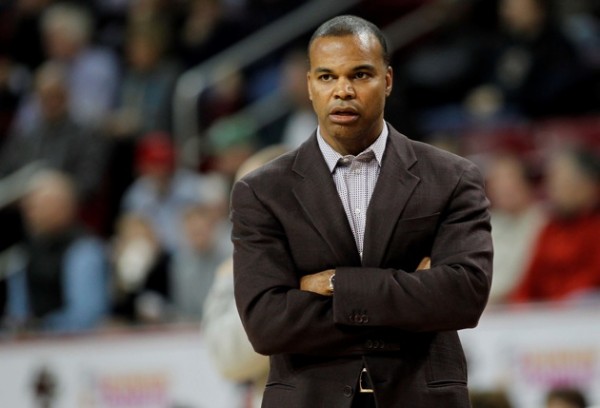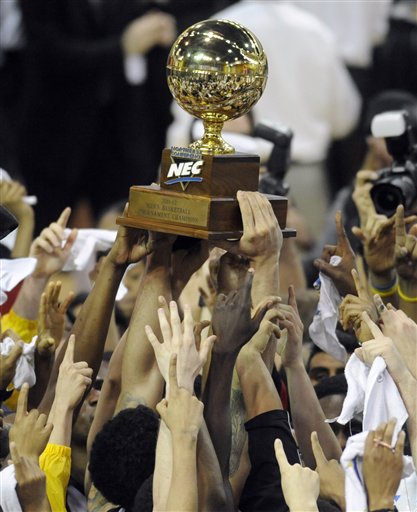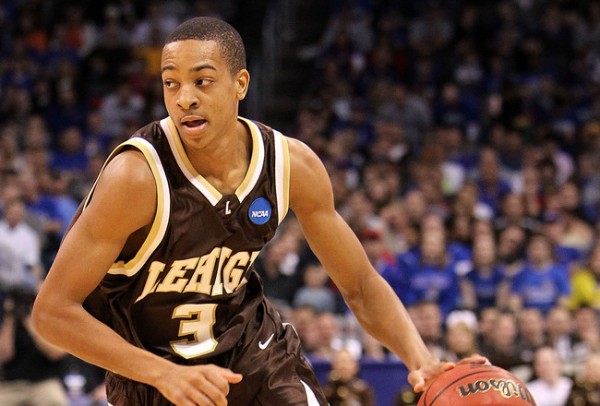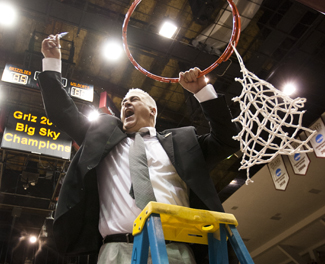Bracket Prep: Davidson, Harvard, LIU, Lehigh & Montana
Posted by EJacoby on March 8th, 2012As we move through Championship Week, we’ll continue to bring you short reviews of each of the automatic qualifiers to help you fill out your bracket next week. In this post, we have your SoCon, Ivy, NEC, Patriot, and Big Sky conference champions. Here’s what you need to know about these recent bid winners.
Davidson
- Southern Conference Champion (25-7, 19-2)
- RPI/Pomeroy/Sagarin = #66/#67/#69
- Adjusted Scoring Margin = +8.8
- Likely NCAA Seed: #13-#14
Three Bruce Pearls of Wisdom.
- First of all, let’s put this to rest immediately. Although Davidson’s record of 25-7 is nearly the same as it was in 2008 when the Wildcats came within a long three-pointer of the Final Four, this year’s team is not nearly as good as that one, led by a young Stephen Curry. But it wouldn’t be a Bob McKillop-coached team if it wasn’t dangerous, and the Wildcats are certainly that, as their mid-December upset win over likely #1 seed Kansas attests. Led by a group of sophomores and juniors who can score inside and out, Davidson likes to get out in transition and spread the floor in the halfcourt. All five starters are capable of hitting the three-ball (34% to 37%), and although the Wildcats won’t beat you that way, they use the threat of it to find easy looks inside. Whoever draws this team in its first game will have its hands full with the Davidson offense.
- McKillop’s defense, however, is a bit of a different story. The Wildcats don’t turn teams over and, at least against good opponents, have a lot of trouble stopping dribble penetration. Duke dropped 82 on the Wildcats as Austin Rivers and Seth Curry had 17 points each; Vanderbilt went for 87 as Jeffery Taylor and John Jenkins combined for 52 points; Wichita State had 91 in a win where Joe Ragland dropped 30 and his backcourt mate Toure’ Murray added 16 more. You get the point. Athletic scoring guards are a big problem for the Wildcats.
- Given those conditions, Davidson is projected to play a #3 or #4 seed in next week’s NCAA Tournament. Among the teams in that group, there are a few that they absolutely do not want to see under any circumstances. For example, Michigan’s Trey Burke and Tim Hardaway, Jr., would be disastrous. On the other hand, Georgetown’s Jason Clark and Martel Starks would be much more manageable. As the Wildcats have already shown against the Jayhawks once this year, they are a dangerous squad if the conditions are right. We wouldn’t bet on them pulling another first game upset this year, but keep an eye on teams built like them (high offense, no defense) for possible victims.
Harvard
- Ivy League Champion (26-4, 12-2)
- RPI/Pomeroy/Sagarin = #36/#38/#43
- Adjusted Scoring Margin = +8.4
- Likely NCAA Seed: #10-#11
Three Bruce Pearls of Wisdom.
- Harvard basketball has been in the news a lot lately, mostly due to former player Jeremy Lin’s emergence as an NBA star point guard. But when Tommy Amaker and his team watched Penn lose to Princeton on Tuesday night, the Crimson sealed their first NCAA Tournament berth in 66 years. Not once did this team make it during Lin’s tenure, and Harvard is finally back in the Big Dance this year thanks to a terrific defense and overall efficient team. This squad challenged itself in the non-conference and won the Battle for Atlantis Tournament that included a field of Connecticut and Florida State. They also defeated St. Joseph’s and finished with a strong 12-2 record in the Ivy League with only two close losses to top competitors Princeton and Penn.
- The Crimson use a balanced attack that goes eight players deep with useful contributors. Kyle Casey and Keith Wright form a strong post duo of efficient forwards. Though both players are undersized, they each have polished post moves and average double-figure scoring. Wright leads the team with 8.1 rebounds and 1.4 blocks per game. Nearly everyone else in the rotation is capable of hitting from the perimeter, including sophomore Laurent Rivard who led the conference in true shooting percentage. Brandyn Curry runs the show and averages 5.0 assists per night. All of these players have bought into Amaker’s system and play strong collective defense on the other end.
- Harvard will be a very interesting matchup in the NCAA Tournament. This team can pose a problem for a power conference team that doesn’t run a disciplined offense, though that could be a rare scenario for a #6-seed kind of team that it will match up against. Nonetheless, Harvard’s defense will give a team fits. The Crimson give up 54.8 points per game this year, the fourth-least in the country. And it’s not just the slow pace; their 89.9 defensive efficiency ranks #10 nationally. Harvard was able to control tempo and outplay St. Joe’s and UCF in the non-conference, but it didn’t play well against UConn’s superior athletic defense. Harvard will surely be an interesting #10 or #11 seed in a game of likely contrasting styles.
LIU-Brooklyn
- NEC Champion (25-8, 19-2)
- RPI/Pomeroy/Sagarin = #87/#174/#163
- Adjusted Scoring Margin = +2.6
- Likely NCAA Seed: #15-#16
Three Bruce Pearls of Wisdom.
- Long Island made the NCAA Tournament last year behind an exciting, up-tempo offense. The Blackbirds dropped in the first round to North Carolina in a super fast-paced game, 102-87. It’s much of the same this year for LIU, a team with the sixth-fastest pace in Division I with play-makers spread throughout the offense. Jim Ferry’s team has the experience of last year’s Big Dance and the players have no fear of attacking the basket and playing aggressively. That kind of style has been very effective in the Northeast Conference, but can it work in an NCAA Tournament?
- The skilled forward duo of Julian Boyd and Jamal Olasewere is what makes this team so dangerous. Olasawere scores 16.8 points per game and is effective all over the floor with long arms to create havoc on defense. Boyd is an efficient big that averages 17.4 points and 9.5 boards per game, and both players shoot over 55% from the floor. But the key this year is the emergence of point guard Jason Brickman, who dishes 7.3 assists per game and is a clutch shooter at 82% from the foul line.
- LIU-Brooklyn scores 81.9 points per game, third in the country. But it also surrenders over 77 points per game as well. Opponents know what they’re in for when matching up against this team, which is why it should not give any #1 or #2 seed a problem in the first round. Teams like Ohio State and North Carolina will have no problem playing an up-tempo game with their elite athletes able to show off in the open court. It will make for an exciting game to watch, but not likely to produce an early upset. The Blackbirds’ best shot will be to employ a more disciplined attack on offense by pounding the ball inside to their duo of bigs to try to get opposing forwards in foul trouble. But anything can happen in a one-game scenario, and perhaps the team can get lucky and match up with an opponent that’s not used to such a breakneck pace, like Michigan State.
Lehigh
- Patriot League Champion (26-7, 14-3)
- RPI/Pomeroy/Sagarin = #103/#81/#91
- Adjusted Scoring Margin = +7.1
- Likely NCAA Seed: #14-#15
Three Bruce Pearls of Wisdom.
- Brett Reed’s Mountain Hawks are back in the NCAA Tournament for the second time in three years. In 2010, Lehigh actually gave top overall #1 seed Kansas a run for its money before losing, 90-74. This year’s team is more experienced and talented, with four out of five starters being upperclassmen including a star guard that was Patriot League Player of the Year. The Mountain Hawks have no great wins this season, but they played true road games at Michigan State, Iowa State, and St. John’s and lost each one by single digits.
- C.J. McCollum is the conference Player of the Year and a fantastic all-around guard. The junior averaged 21.9 points, 6.5 rebounds, 3.5 assists, and 2.6 steals per game this season as the team leader that can find his own shot and make plays for others. He’s a bit undersized for a two-guard but makes up for that with great quickness and handle off the dribble. Gabe Knutson is another key player as the team’s low-post scoring threat that averages 12 points per game on 50% shooting. Mackey McKnight is the point guard who often defers to McCollum but is also adept at finding the star off cuts and screens. He averages 3.7 assists per game.
- Lehigh was the Patriot League’s most efficient team on both offense (111.0) and defense (94.8), ranking in the top 25 nationally in offensive efficiency. The Mountain Hawks don’t shoot it great from beyond the arc but are a fantastic free-throw shooting team, ranking second in Division I at 77.6% from the charity stripe. Lehigh has a solid defensive efficiency but doesn’t have very much bulk on the inside. It allowed Mike Muscala to go for 30 points and 14 rebounds in the conference championship and will have much trouble stopping a team with interior strength. The ‘Hawks only get three blocks per game as a team. They will hope to receive a #14 seed and match up against an opponent that can’t run them out of the gym or dominate them inside, such as Michigan. Lehigh could possibly make things happen against one of those power teams that play zone and don’t feature an interior scorer. But any other matchups, like Missouri, Marquette, Ohio State, or Duke will pose a major problem for this undersized team.
Montana
- Big Sky Champion (25-6, 17-2)
- RPI/Pomeroy/Sagarin = #75/#87/#98
- Adjusted Scoring Margin = +7.4
- Likely NCAA Seed: #14-#15
Three Bruce Pearls of Wisdom.
- The Montana Grizzlies are also back in the Big Dance for the second time in three seasons, where they most recently played a tough game as a #14 seed against #3 New Mexico in a five-point loss. That happened to be a perfect matchup for Montana against what was perhaps an overseeded Lobos team. This year, Montana hopes to receive another crack at an upset as a #14 seed, where four of its top six players this year were all part of the team in that last NCAA Tournament. The Grizzlies have been quite successful in Wayne Tinkle’s six-year tenure and should be taken seriously in round one.
- Will Cherry leads the way as an exciting guard that averages 16.0 points, 3.9 rebounds, 3.4 assists, and 2.6 steals per game, and he’s joined by the bigger guard Kareem Jamar who contributes more on the wing (45% three-point shooter) and on the boards with 5.6 rebounds per game. Derek Selvig provides needed size as a seven-footer that grabs 6.1 rebounds per game and can make impact plays on defense with 1.2 blocks and 1.0 steals per night. He only scores 9.2 points per game, however, on 40% shooting, very low for a big man. These three are all leaders defensively, as well, of a unit that has excelled defensively in the Big Sky.
- This team has solid balance offensively with five players that average at least 9.2 points per game, and the aforementioned Cherry and Jamar can make plays to score. More importantly, this team excels on the defensive end with a season-long defensive efficiency of 92.5 that ranked #30 in the nation. The Grizzlies force a lot of turnovers and don’t allow teams to hit many threes (five per game, 32.4%), though they aren’t particularly strong on the boards. Montana’s 48.7% overall rebound percentage ranks #257 in the country. This team will have trouble with an athletic front line that won’t have trouble going over the smaller wing players or around the seven-footer Selvig. But Montana could match up decently against a team that tries to win behind scoring guards, like its main conference competitor Weber State tried. The Grizzlies can lock up on perimeter defense with solid guards, so they would probably rather draw a team like Duke or Missouri than Ohio State or Baylor.





























